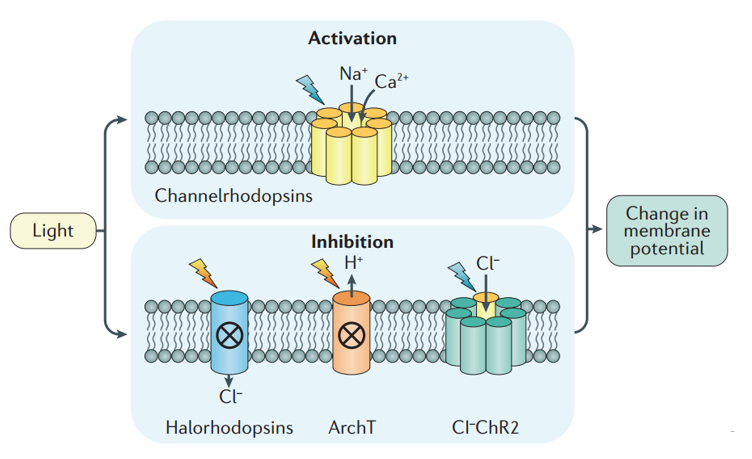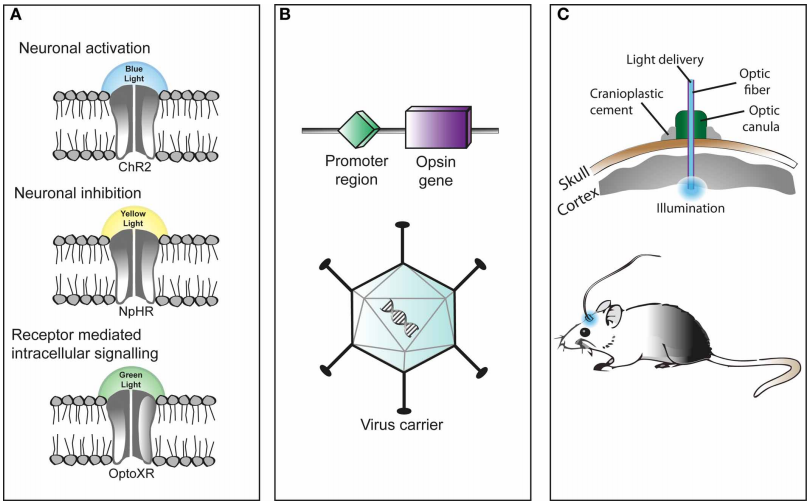Optogenetics Actuators
Optogenetics denotes “optical stimulation plus genetic engineering”, which integrates optics and genetic engineering to manipulate cells and their information processes. Optogenetics has been broadly applied to study neural circuit structure,activity, function as well as cell physiology of none-neuronal systems.
The concepts of different actuators for activation and inhibition of cells. The stimulus is indicated on the left-hand side (light). The cellular actions, shown on the right, could be changes either in membrane potential. (Werend Boesmans, Nature Reveiews, 2017)
Optogenetic actuators are usually microbial opsins which conduct the flow of ions into or out of cells by illumination at a specific wavelength. A variety of natural microbial opsins have been identified and series of engineering have been conducted to improve precision of spatiotemporal control and to expand absorption spectrum.
Below is a brief overview of the commonly used microbial opsins. Also, the list is not exhaustive.
BrainVTA could offer relevant packaging services, for the pre-made AAV tools, please visit the
pre-made AAV center.
Channelrhodopsins are cation channels discovered in the green algae Chlamydomonas reinhardtii and open when excited by blue light, which in turn depolarizes cells and often evokes action potentials in neurons. Naturally occurred channelrhodopsins include Channelrhodopsin-1 (ChR1) and Channelrhodopsin-2 (ChR2). ChR2 is more commonly used than ChR1 since ChR2 has a higher conductance at physiological pH and is efficiently located to the membrane.
ChR Variants
|
Variant |
Description |
Peak (nm) |
|
ChR2 |
From Chlamydomonas reinhardtii |
470 |
|
ChR2/H134 |
Widely used; larger photocurrent compared to CrChR2 |
450 |
|
ChETA |
E123T mutation; faster kinetics |
490 |
|
ChR/T159C |
T159C mutation |
470 |
|
ReaChR |
Red-activatable variant of ChR2 |
590 |
|
C1V1 |
ChR1-VChR1 chimera with E122T and E162T mutations |
540 |
|
VChR1 |
from Volvox carteri |
570 |
|
Chronos |
High-speed, light-sensitive channel from Stigeoclonium helveticum |
500 |
|
ChrimsonR |
K176R mutation;Red-light drivable ; from Chlamydomonas noctigama. |
590 |
Halorhodopsins
Halorhodopsins are chloride pumps isolated from Halobacteria and transport chloride into cells when illuminated by yellow light which results in cell hyperpolarization. Its variants include NpHR, eNpHR2.0, eNpHR3.0 and Jaws, among which Jaws have a red-shifted absorbance peak and are often used to silent neural activities.
Archaerhodopsins
Archaerhodopsin (Arch) from Halorubrum sodomense is also commonly used to inhibit neural activities which is triggered by green-yellow light. ArchT, eArch3.0, and eArchT3.0 are identified Arch variants.
Optogenetic stimulation consists of several steps. (E. A. Claudia Pama , Lorenza S. Colzato ,and Bernhard Hommel, Frontiers in psychology, 2013)
Are you designing your optogenetics experiment? If you have any requisition or questions, you may email us at
sales@brainvta.com or click the
Send Request button.
References
1. Werend Boesmans1,2, Marlene M. Hao1,3 and Pieter Vanden Berghe1.Optogenetic and chemogenetic techniques for neurogastroenterology.Published online 29 Nov 2017,REVIEWS.
2. Boyden ES, Zhang F, Bamberg E, Nagel G, Deisseroth K. 2005. Millisecond-timescale, genetically targeted optical control of neural activity. Nat Neurosci. 8(9):1263-8.
3. Deisseroth K, Feng G, Majewska AK, Miesenböck G, Ting A, Schnitzer MJ. 2006. Next-generation optical technologies for illuminating genetically targeted brain circuits. J Neurosci. 26(41):10380-6.
4. Kim B, Lin MZ. 2013. Optobiology: optical control of biological processes via protein engineering. Biochem Soc Trans. 41(5): 1183–1188.
5. Enhancing Channelrhodopsins: An Overview .Optogenetics: Methods and Protocols, Methods in Molecular Biology, vol. 1408
6. The Optogenetic Catechism .Gero MiesenböckScience 326, 395 (2009).

